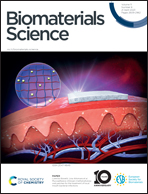The diversified hydrogels for biomedical applications and their imperative roles in tissue regeneration
Abstract
Repair and regeneration of tissues after injury are complex pathophysiological processes. Microbial infection, malnutrition, and an ischemic and hypoxic microenvironment in the injured area can impede the typical healing cascade. Distinguished by biomimicry of the extracellular matrix, high aqueous content, and diverse functions, hydrogels have revolutionized clinical practices in tissue regeneration owing to their outstanding hydrophilicity, biocompatibility, and biodegradability. Various hydrogels such as smart hydrogels, nanocomposite hydrogels, and acellular matrix hydrogels are widely used for applications ranging from bench-scale to an industrial scale. In this review, some emerging hydrogels in the biomedical field are briefly discussed. The protective roles of hydrogels in wound dressings and their diverse biological effects on multiple tissues such as bone, cartilage, nerve, muscle, and adipose tissue are also discussed. The vehicle functions of hydrogels for chemicals and cell payloads are detailed. Additionally, this review emphasizes the particular characteristics of hydrogel products that promote tissue repair and reconstruction such as anti-infection, inflammation regulation, and angiogenesis.



 Please wait while we load your content...
Please wait while we load your content...